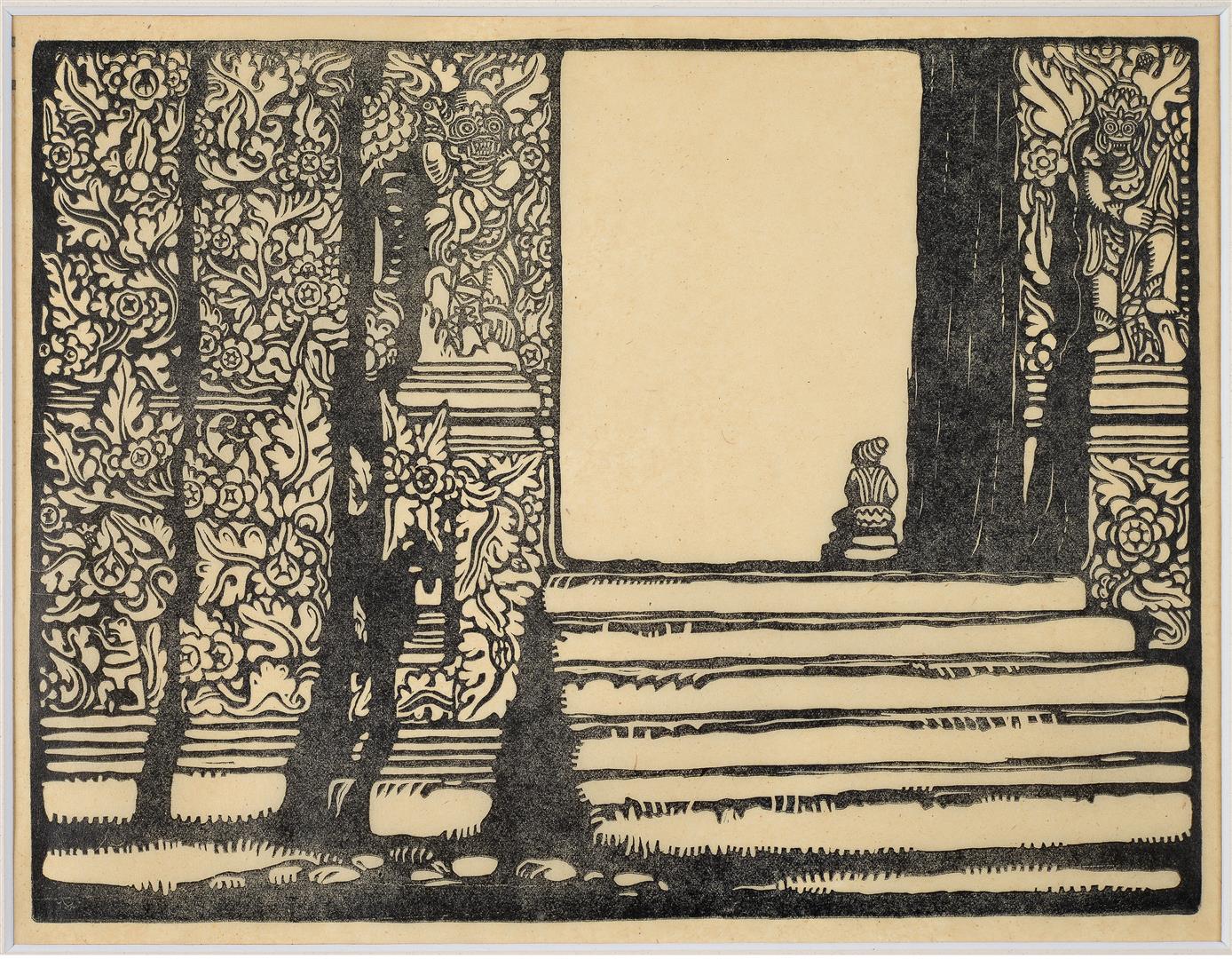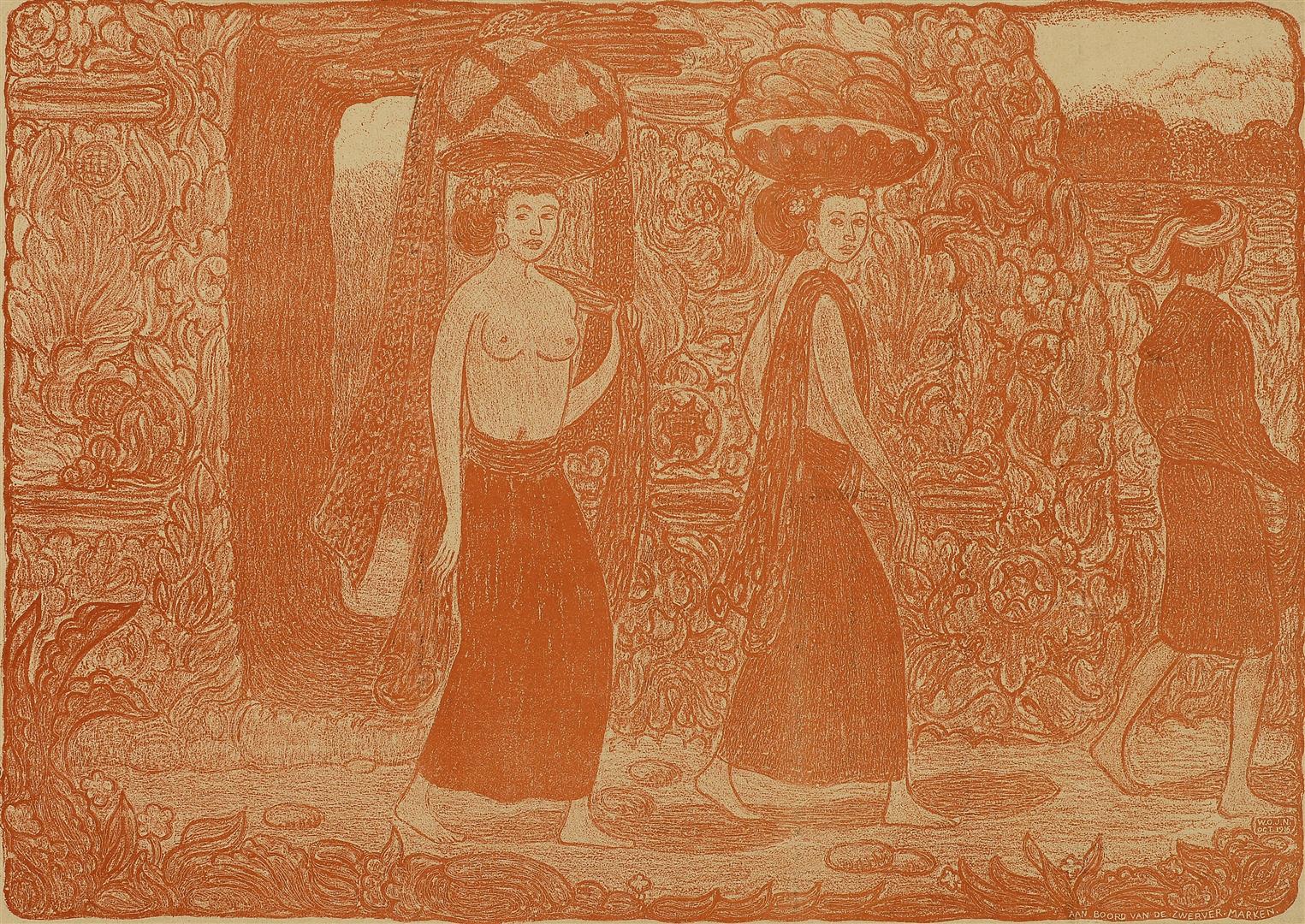'Heilig bos in Bali' / Sacred forest in Bali signed with initials and dated 'WOJN 4.2.37.', titled and name artist (with ink on the reverse) pencil on paper, unframed, 46x39 cm Provenance: -Acquired directly from the artist in 1948 by H. Heller-De Roo (for Dfl. 250,-). Thence by descent in the family for more than 70 years. Nature seems to have been more of an inspiration to the artist W.O.J. Nieuwenkamp than mankind ever was. Especially the magnificence of trees fascinated him; in many of his compositions of early 20th century Java and Bali, bamboo plants, sacred Waringin trees, gigantic hell trees, coconut palms, and nutmeg trees predominated. Nieuwenkamp’s granddaughter once shared her opinion with me that Nieuwenkamp was not really that interested in people, not even his own children or grandchildren. His life was completely dedicated to art. According to her, this had resulted in people mostly being portrayed in his drawings and paintings as miniatures. The present lot is a typical example of Nieuwenkamp’s fascination for Mother Nature, and his vast knowledge of Balinese culture. Being the first European artist to visit Bali in 1904, having witnessed one of the horrific South-Balinese puputans in 1906, and having travelled through the Indonesian archipelago six times from 1898-1937, Nieuwenkamp had become one of the leading experts on its culture, art and crafts. He had authored and published books, organised exhibitions of his extensive ethnographic collection in leading European museums, and was an established graphic artist. In what would become his last trip to Java and Bali, in the first months of 1937, he was able to conjoin all the knowledge and network he had gathered over those past 30 years. Nieuwenkamp travelled to Batavia, via Semarang to Surabaya, and arrived on Bali for the fifth time, on 7 January 1937. During this stay on Bali, lasting three months, he met up with old friends like Rudolf Bonnet (1895-1978), Walter Spies (1895-1942), Beryl de Zoete (1879-1962), and Dr. Roelof Goris (1898-1965). There was also business to take care of; he had been asked by the Volksuniversiteit Rotterdam to acquire a large amount of Balinese woodcarvings, both traditional and art-deco style, which, as funny as it may sound now, would serve as ‘Christmas premiums’ for the University members. In the end, this December 1937 (sales) exhibition would boast much more than only woodcarvings, and would also include some of his own lithographs and drawings, and a number of drawings by Rudolf Bonnet On Bali, Nieuwenkamp also visited some of the iconic temples, palaces, and forests which he had encountered during earlier trips, or which he himself had discovered, like the ancient stone reliefs of Yeh Pulu. In July 1925, Nieuwenkamp had been mesmerised by The Sacred Forest of Sangeh, and the impressive flora he described as ‘djeboeg aroem’. At that time, he had also made a drawing of these tall dignified trees, which can grow to a height of 40 meters, and had written in his travel journal: ‘This solemn forest consists of wild nutmeg trees, high and straight as a line, of which the foliage is shaped like the vaults of a cathedral. It is just as dusky and as mysterious as a cathedral too.’ (source: travel journal Nieuwenkamp, 1925; archive of Cary Venselaar). Indeed, Sangeh Forest is considered (part of) a sanctuary, since there are four 17th-century temples, of which the Pura Bukit Sari is the largest. On 4 February 1937, Nieuwenkamp visited Sangeh again, just north-west of Ubud. Although he was known to roam about on a bicycle, he now went by car, accompanied by his friend van Ravenswaay. The primordial trees made a huge impression on Nieuwenkamp once more. Just like it had impressed Walter Spies, who had immortalised the Sacred Forest of Sangeh in 1928. Both artists had not only portrayed the flora, but the insolent inhabitants of the forest too; grey, long-tailed macaque monkeys. "By car to the Sacred Forest of Sangeh. I w
'Heilig bos in Bali' / Sacred forest in Bali signed with initials and dated 'WOJN 4.2.37.', titled and name artist (with ink on the reverse) pencil on paper, unframed, 46x39 cm Provenance: -Acquired directly from the artist in 1948 by H. Heller-De Roo (for Dfl. 250,-). Thence by descent in the family for more than 70 years. Nature seems to have been more of an inspiration to the artist W.O.J. Nieuwenkamp than mankind ever was. Especially the magnificence of trees fascinated him; in many of his compositions of early 20th century Java and Bali, bamboo plants, sacred Waringin trees, gigantic hell trees, coconut palms, and nutmeg trees predominated. Nieuwenkamp’s granddaughter once shared her opinion with me that Nieuwenkamp was not really that interested in people, not even his own children or grandchildren. His life was completely dedicated to art. According to her, this had resulted in people mostly being portrayed in his drawings and paintings as miniatures. The present lot is a typical example of Nieuwenkamp’s fascination for Mother Nature, and his vast knowledge of Balinese culture. Being the first European artist to visit Bali in 1904, having witnessed one of the horrific South-Balinese puputans in 1906, and having travelled through the Indonesian archipelago six times from 1898-1937, Nieuwenkamp had become one of the leading experts on its culture, art and crafts. He had authored and published books, organised exhibitions of his extensive ethnographic collection in leading European museums, and was an established graphic artist. In what would become his last trip to Java and Bali, in the first months of 1937, he was able to conjoin all the knowledge and network he had gathered over those past 30 years. Nieuwenkamp travelled to Batavia, via Semarang to Surabaya, and arrived on Bali for the fifth time, on 7 January 1937. During this stay on Bali, lasting three months, he met up with old friends like Rudolf Bonnet (1895-1978), Walter Spies (1895-1942), Beryl de Zoete (1879-1962), and Dr. Roelof Goris (1898-1965). There was also business to take care of; he had been asked by the Volksuniversiteit Rotterdam to acquire a large amount of Balinese woodcarvings, both traditional and art-deco style, which, as funny as it may sound now, would serve as ‘Christmas premiums’ for the University members. In the end, this December 1937 (sales) exhibition would boast much more than only woodcarvings, and would also include some of his own lithographs and drawings, and a number of drawings by Rudolf Bonnet On Bali, Nieuwenkamp also visited some of the iconic temples, palaces, and forests which he had encountered during earlier trips, or which he himself had discovered, like the ancient stone reliefs of Yeh Pulu. In July 1925, Nieuwenkamp had been mesmerised by The Sacred Forest of Sangeh, and the impressive flora he described as ‘djeboeg aroem’. At that time, he had also made a drawing of these tall dignified trees, which can grow to a height of 40 meters, and had written in his travel journal: ‘This solemn forest consists of wild nutmeg trees, high and straight as a line, of which the foliage is shaped like the vaults of a cathedral. It is just as dusky and as mysterious as a cathedral too.’ (source: travel journal Nieuwenkamp, 1925; archive of Cary Venselaar). Indeed, Sangeh Forest is considered (part of) a sanctuary, since there are four 17th-century temples, of which the Pura Bukit Sari is the largest. On 4 February 1937, Nieuwenkamp visited Sangeh again, just north-west of Ubud. Although he was known to roam about on a bicycle, he now went by car, accompanied by his friend van Ravenswaay. The primordial trees made a huge impression on Nieuwenkamp once more. Just like it had impressed Walter Spies, who had immortalised the Sacred Forest of Sangeh in 1928. Both artists had not only portrayed the flora, but the insolent inhabitants of the forest too; grey, long-tailed macaque monkeys. "By car to the Sacred Forest of Sangeh. I w















Testen Sie LotSearch und seine Premium-Features 7 Tage - ohne Kosten!
Lassen Sie sich automatisch über neue Objekte in kommenden Auktionen benachrichtigen.
Suchauftrag anlegen